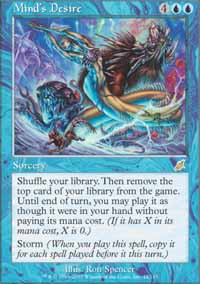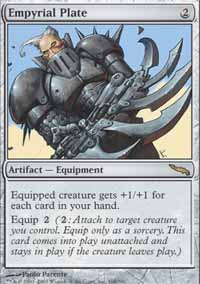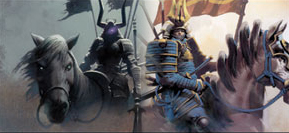
I have had a bad habit since I started playing Magic back in the year 2000: I constantly go through start and stop phases. What I mean by that is: I will play every week or every other week for months, at the longest 2 years, and then suddenly stop and lose interest in the game. [float=right]

This was the first deck I ever lost to
after coming back for the third time.[/float] Since my start of tournament play in 2000, I have “given up” the game 4 times – once after Invasion rotated, after the release of Onslaught, after Mirrodin rotated, and one last time after the release Future Sight. But no matter how hard I tried, I would always find myself back at the card shop and scouring the internet for deck ideas and thinking up absurd combos in the shower, in class, and in my sleep. So, as a self-proclaimed master at being a “Re-Starter”, I am here to give you my Top 3 tips for getting back into the game.
1. START WITH DRAFTING
Seems like an odd request at first, I know, and I can sense that many of you reading this now are questioning my logic on this, but bear with me for a moment. After being out of the game for a few months or years even you have no idea what a proper deck is and you won’t until you familiarize yourself with the sets that are out there. There are two ways to do this – spend hours memorizing the Gatherer entries – or just draft. Drafting allows a player to see the cards first hand with a minimized worry of failure as they can find the good and bad cards as they go along. Will you lose your first draft or two back? Probably, and it may seem like a waste of $30 in order to disprove that theory, but that is really up to you as the player and payer for the evening. So instead of arguing semantics, let’s take a look at drafting and constructing a Standard legal deck mathematically.
In a standard 8 man draft you will see around 250 different cards; 15 in the first pick, 14 in the second, so on and so forth for 7 picks, times three packs. Proportionally, you will see drastically more unique cards, somewhere around 55-65 in a larger set (Time Spiral) and 40-50 in a smaller set (Morningtide). This becomes the key setback for people getting back into the game; most people want to focus on a few ideas and really get to know a fewer group of cards more intimately; however, even just by seeing and play with around 20% of a set can be extremely helpful. This gives you a feel for the mechanics and flavor and design of each set; especially since lately, Wizards has been pushing very strongly themed sets – See Ravinca and Lorwyn Blocks as prime examples. Things are different if you are drafting triple Core Set, however rare that is, but this is only because a Core Set is released every two and a half years, and from my experience, people get tired to Triple Core Set very, very quickly. But for arguments sake, tonight we are going to draft three packs of Tenth Edition. In this draft you will see somewhere around 65-80 unique cards – more unique cards seen, with more repetition because of the way Core Sets are packaged. This drops the proportion of set size to amount seen, but gives more insight overall for the one set. This is extremely important because it allows you as a “new” player to get used to the cards, the tempo of the game, at least in the Limited format, and how to appropriately use the cards in the sets together.
When drafting a whole block, say Ravnica block, the ratios are slightly different because you see fewer cards from each set, however you will see around 30% of the block as a whole, [float=left]

One of the many cards I thought was good.[/float] which I think is much more valuable than seeing around 15-20% of one set.
At this point, for those of you that still don’t believe or agree with me, let’s put my math to the test with a Time Spiral Block draft. I will be Player A, drafting with 7 bots. Let’s test it out. (A * is a card I forgot.[/float])
Draft: Pack 1: Flamecore Elemental, Mana Skimmer, Nantuko Shaman, Coral Trickster, Benalish Cavalry, Clockspinning, Sidewinder Sliver, Viscid Lemures, Mwonvuli Acid-Moss, Two-Headed Sliver, Yavimaya Dryad, Firewake Sliver, Firemaw Kavu, Spectral Force, Essence Sliver
Pack 2: Penumbra Spider, Pentarch Ward, Assassinate, Thallid Germinator, Zealot il-Vec, Ironclaw Buzzardiers, Psychotic Episode, Jedit's Dragoons, Sprout, Think Twice, Weatherseed Totem, Locket of Yesterdays, Fungus Sliver, Uncle Istvan
Pack 3: Feebleness, Looter il-Kor, Spinneret Sliver, Keldon Halberdier, Grapeshot, Blazing Blade Askari, Shadow Sliver, Ophidian Eye, Watcher Sliver, Tectonic Fiend, Aspect of Mongoose, Dementia Sliver, Vesuva
Pack 4: Ironclaw Buzzardiers, Search for Tomorrow, Icatian Crier, Goblin Skycutter, Drifter il-Dal, Basal Sliver, Sage of Epityr, Ghitu Firebreathing, Phyrexian Totem, Ghostflame Sliver, Gauntlet of Power, Whispers of the Muse
Pack 5: Tolarian Sentinel, Flowstone Channeler, Fortify, Spiketail Drakeling, Wormwood Dryad, Mystical Teachings, Two-Headed Sliver, Prismatic Lens, Return to Dust, Urza's Factory, Mountain
Pack 6: Zealot il-Vec, Snapback, Aether Web, Momentary Blink, Greenseeker, Pit Keeper, Divine Congregation, Dreadship Reef, Haunting Hymn
Pack 7: Flamecore Elemental, Feebleness, Chromatic Star, Venser's Sliver, Clockspinning, Bogardan Rager, D'Avenant Healer, Assembly-Worker, Squire
Pack 8: Drudge Reavers, Jhoira's Timebug, Chameleon Blur, Cyclopean Giant, Screeching Sliver, Spell Burst, Wheel of Fate, Feldon's Cane
Pack 9: Mana Skimmer, Coral Trickster, Clockspinning, Sidewinder Sliver, Viscid Lemures, Mwonvuli Acid-Moss, Firewake Sliver
Pack 10: Pentarch Ward, Psychotic Episode, Sprout, Foriysian Interceptor, Locket of Yesterdays, Uncle Istvan
Pack 11: Blazing Blade Askari, Shadow Sliver, Ophidian Eye, Tectonic Fiend, Return to Dust
Pack 12: Drifter il-Dal, Sage of Epityr, Ghitu Firebreathing, Gemstone Caverns
Pack 13: Mystical Teachings, Return to Dust, Mountain
Pack 14: Divine Congregation, Dreadship Reef
Pack 15: Squire
Pack 16: Needlepeak Spider, Poultice Sliver, Giant Dustwasp, Dead / Gone, Dreamscape Artist, Fury Charm, Vitaspore Thallid, Deadly Grub, Primal Plasma, Simian Spirit Guide, Sinew Sliver, Hammerheim Deadeye, Sophic Centaur, Damnation, Boom / Bust
Pack 17: Veiling Oddity, Ridged Kusite, Saltfield Recluse, Dust Corona, Reality Acid, Blightspeaker, Evolution Charm, Shade of Trokair, Sinew Sliver, Essence Warden, Bog Serpent, Dismal Failure, Keen Sense, Jedit Ojanen of Efrava
Pack 18: Shaper Parasite, Battering Sliver, Mire Boa, Utopia Vow, Pallid Mycoderm, Uktabi Drake, Deadly Grub, Bog Serpent, Merfolk Thaumaturgist, Skirk Shaman, Psychotrope Thallid, Frozen Aether, Vorosh, the Hunter
Pack 19: Spitting Sliver, Evolution Charm, Pallid Mycoderm, Brain Gorgers, Dust Corona, Vitaspore Thallid, Simian Spirit Guide, Fa'adiyah Seer, Primal Plasma, Darkheart Sliver
Pack 20: Spitting Sliver, Stingscourger, Dash Hopes, Shade of Trokair, Vitaspore Thallid, Melancholy, Merfolk Thaumaturgist, Gossamer Phantasm, Jodah's Avenger, Imp's Mischief, Wistful Thinking
Pack 21: Midnight Charm, Uktabi Drake, Ghost Tactician, Firefright Mage, Wistful Thinking, Keldon Marauders, Essence Warden, Simian Spirit Guide, Hunting Wilds, Frenetic Sliver
Pack 22: Midnight Charm, Brain Gorgers, Fury Charm, Wistful Thinking, Firefright Mage, Fa'adiyah Seer, Big Game Hunter, Hammerheim Deadeye
Pack 23: Synchronous Sliver, Dawn Charm, Dash Hopes, Aquamorph Entity, Melancholy, Vampiric Link, Dunerider Outlaw, Fatal Frenzy
Pack 24: Needlepeak Spider, Poultice Sliver, Fury Charm, Vitaspore Thallid, Deadly Grub, Simian Spirit Guide, Sophic Centaur
Pack 25: Ridged Kusite, Reality Acid, Essence Warden, Bog Serpent, Dismal Failure, Keen Sense
[float=left]

One of the few cards I correctly analyzed
when coming back.[/float]Pack 26: Deadly Grub, Bog Serpent, Merfolk Thaumaturgist, Psychotrope Thallid, Frozen Aether
Pack 27: Brain Gorgers, Dust Corona, Vitaspore Thallid, Fa'adiyah Seer
Pack 28: Dash Hopes, Vitaspore Thallid, Wistful Thinking
Pack 29: Firefright Mage, Wistful Thinking
Pack 30: Fa'adiyah Seer
Pack 31: Wrap in Vigor, Samite Censer-Bearer, Infiltrator il-Kor, Rift Elemental, Fomori Nomad, Patrician's Scorn, Logic Knot, Nessian Courser, Grave Scrabbler, Henchfiend of Ukor, Spin into Myth, Yixlid Jailer, Storm Entity, Nix, Ghostfire
Pack 32: Samite Censer-Bearer, Aven Augur, Ichor Slick, Bogardan Lancer, Knight of Sursi, Grave Peril, Lucent Liminid, Vedalken Aethermage, Virulent Sliver, Frenzy Sliver, Ghostfire, *, Mistmeadow Skulk, Dryad Arbor
Pack 33: Leaden Fists, Augur of Skulls, Lost Hours, Lumithread Field, Mesmeric Sliver, Deepcavern Imp, Flowstone Embrace, Nessian Courser, Blade of the Sixth Pride, Street Wraith, Bloodshot Trainee, Spellwild Ouphe, Spellwild Ouphe
Pack 34: Cutthroat il-Dal, Llanowar Augur, Augur of Skulls, Lumithread Field, Grinning Ignus, Edge of Autumn, Deepcavern Imp, Fomori Nomad, Logic Knot, Narcomoeba, Fleshwrither, Skizzik Surger
Pack 35: Bogardan Lancer, Venser's Diffusion, Oblivion Crown, Saltskitter, Infiltrator il-Kor, Sarcomite Myr, Henchfiend of Ukor, Blind Phantasm, Boldwyr Intimidator, Phosphorescent Feast, Whetwheel
Pack 36: Unblinking Bleb, Llanowar Augur, Blind Phantasm, Virulent Sliver, Mass of Ghouls, Vedalken Aethermage, Blade of the Sixth Pride, Witch's Mist, Emblem of the Warmind, Phosphorescent Feast
Pack 37: Llanowar Empath, Marshaling Cry, Unblinking Bleb, Lost Hours, Wrap in Vigor, Whip-Spine Drake, Grave Scrabbler, Ramosian Revivalist, Arcanum Wings
Pack 38: Petrified Plating, Leaden Fists, Quiet Disrepair, Homing Sliver, Edge of Autumn, Zoetic Cavern, Bitter Ordeal, Oblivion Crown
Pack 39: Wrap in Vigor, Samite Censer-Bearer, Patrician's Scorn, Grave Scrabbler, Yixlid Jailer, Storm Entity, Nix
Pack 40: Samite Censer-Bearer, Bogardan Lancer, Grave Peril, Vedalken Aethermage, Frenzy Sliver, Dryad Arbor
Pack 41: Augur of Skulls, Lost Hours, Mesmeric Sliver, Spellwild Ouphe, Spellwild Ouphe
Pack 42: Cutthroat il-Dal, Llanowar Augur, Narcomoeba, Fleshwrither
Pack 43: Oblivion Crown, Sarcomite Myr, Phosphorescent Feast
Pack 44: Unblinking Bleb, Phosphorescent Feast
Pack 45: Arcanum Wings
What my final deck was doesn’t matter; this isn’t about my drafting skills. This is about the mathematics. Time Spiral block has 631 cards without the Timeshifted cards. In this draft, minus the Timeshifted cards again, I saw 243 unique cards in three sets. That is 243/631 which equals 38.5% of the block. 38.5% is a large amount for a single draft - the numbers usually end up around 28-34%. Statistically it means that after three drafts you will see the entire block. Is that true? No. It takes around 7-9 drafts to see every common and uncommon in the block. It takes roughly 20+ drafts to see every rare but that is because there are some rare cards that are not meant to be seen after the first pick. A draft deck is 90% commons and uncommons anyway, so seeing every single rare isn’t that important when you are just starting again, you have time to worry about that sort of information.
In fact, these numbers favor drafting in such an overwhelming way that it is actually more detrimental for “RE-Starters” to play a constructed format than it is beneficial for them to draft. It is just flat out stupid to try and get back into the game in reverse fashion. That is why I say to start with drafting.
2. BUILD YOUR OWN DECK
So now that you’ve drafted and seen the set, you want to build a Standard Legal deck as a way to re-sharpen your deck building and running skills. Well, you have two methods for going about this: net decking or making your own deck. Now, net decking has its own redeeming qualities - specifically a higher chance of winning matches and the convenience of just needing to buy singles to finish off the deck. Net decking is a fine practice while you are still active in the game and have been for a while. But when it comes to getting back into Magic, doing this can do more harm than good. Building a deck from scratch does several positive things that net decking can never do: it allows you to find combos and intricacies in cards that may not be used in net decks, it allows you to build against the meta game, and it is downright just a better experience winning with something of your creation than with a deck someone else thought up.
Building against the metagame, especially in Standard, is an extremely difficult thing to do for players who have been involved for years without end; it is nearly impossible for players getting back into the game to get it right the first, second, or even ninth time. When I got back into the game after Mirrodin rotated out of Standard, for the first three weeks back I brought with me a horrid Mono-Black Spirit deck that had almost no synergy and never won a round. But then I started to tweak the deck with cards from Ravnica. Over the course of the next 5 months the deck evolved from Black/Red Suicide Agrro, into Mono-Black Control and eventually into my own version of Black/White Hand in Hand that helped me finish 9th place at my Regionals in 2006. [float=right]

These boys won me a lot of games[/float] The point of that round-a-bout story was that sure I could’ve built Ghost Dad or Red/Green Stompy right off the bat and become extremely good with the deck - Hell I might have even gotten a Top 8 finish with a net deck. But I was much more proud of my 9th place finish with my concoction than I would’ve been with a 1st with a net deck. Winning with your own deck comes with a degree of pride that can’t be gotten from running decks that are known to win. Think of it this way, sure Edison didn’t have actors or a script, but he did invent the movie camera.
Building your own deck also lets you see things that other players who are meta-obsessed might not be able to see. A perfect example of this is the old Enduring Ideal combo deck that was king of my card shop during Kamigawa/Ravnica block standard or the now-infamous Solar Flare deck. Both of these decks were built on theories that metagame players weren’t paying attention to and ironically enough both decks became the cream of the crop for five months of tournament play. And if by some chance, your own deck does become Tier 1, don’t shun it, be proud of it, and don’t stop playing it. It’s your deck; you have the right to win with what you’ve invented.
3. EASE INTO IT
The biggest, biggest, BIGGEST, mistake new and returning players can make is jumping in with both feet…covered with concrete sneakers. Don’t go out and spend $200 each on the three newest sets so you can get a look at all the cards and build a deck based on what you just blew $600 on. Instead my most important and thusly shortest suggestion to all of you “RE-Starters” out there is simple: Make sure you really want back in before you spend a lot of money. Ease your way back in and you will be rewarded much greater than you would be in you ran headfirst into the proverbial brick wall that is Magic: the Gathering.
So there you go, three simple tips for getting back into Magic: draft first, build your own deck, and seriously make sure you are ready to get back into playing. As long as you follow my advice, and learn from your own experiences, you should be able to become a regular player once again, fear not. Take it from a professional “RE-Starter” himself.
Comments